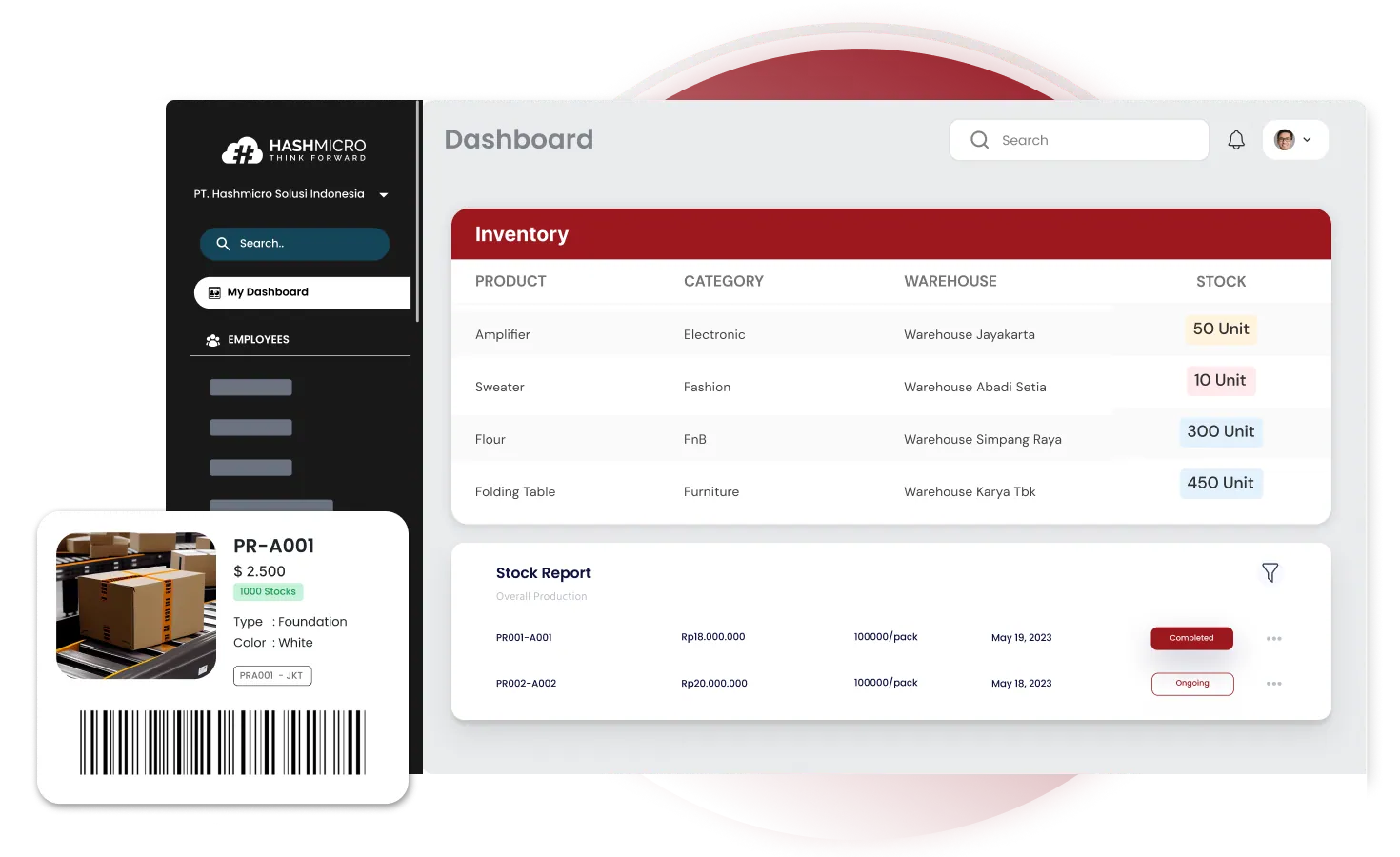Excess inventory is the silent profit killer that ties up cash, wastes warehouse space, and disrupts operational efficiency. When stock levels spiral beyond demand, it’s not just about overfilled shelves, it’s about frozen capital and missed opportunities.
In Singapore’s competitive retail and e-commerce scene, this issue hits even harder. A SIPMM study shows poor inventory control can inflate holding costs (rent, labor, and insurance) by up to 30% of total logistics expenses, hurting your bottom line.
As someone who’s seen how smarter planning changes everything, I believe centralized stock control and real-time tracking are game-changers. Learn how HashMicro’s Inventory Management Software helps eliminate excess stock and improve profitability. Book your free demo today to see it in action.
Key Takeaways
|
What is Excess Inventory?
Excess inventory occurs when stock levels exceed customer demand due to poor forecasting or slow response to sales trends. This ties up capital, wastes warehouse space, and disrupts cash flow.
To prevent this, businesses need accurate real-time data and automated control. Implementing inventory management software helps maintain optimal stock levels, reduce waste, and improve profitability.
What Are the Causes of Excess Inventory?
Excess inventory can stem from several internal and external factors that affect stock planning and replenishment. By identifying these causes, businesses can develop proactive strategies to prevent overstock situations and ensure inventory stays aligned with demand.
1. Overoptimistic demand forecasting
This occurs when businesses predict higher sales than what is realistically achievable. Overly confident forecasts often result from inadequate historical analysis, external pressure, or poor market insights. When the expected demand doesn’t materialize, companies are left with surplus stock that doesn’t move.
2. Overordering
Companies sometimes purchase stock in large quantities to benefit from supplier discounts or meet minimum order quantities. However, this bulk buying can backfire when there is insufficient demand. The excess stock ties up capital and leads to higher storage and maintenance costs over time.
3. Bullwhip effect
The bullwhip effect refers to the phenomenon where small changes in consumer demand cause larger fluctuations in orders upstream. This happens when every participant in the supply chain adds a safety margin, leading to inflated inventory levels. Ultimately, this creates a mismatch between real demand and supply.
4. Too much safety stock
Maintaining buffer inventory to prevent stockouts is a common practice, but excessive safety stock can turn into overstock. Without regular reassessment, businesses may continue to overstock based on outdated assumptions, especially if demand stabilizes or declines unexpectedly.
5. Slow-moving or obsolete inventory
When products lose relevance or market demand shifts, certain items remain unsold and become obsolete. These slow-moving goods clutter warehouse space, increase carrying costs, and are harder to sell without offering significant discounts or markdowns.
6. Seasonality and changing market trends
Fluctuating demand due to seasonal buying patterns or evolving customer preferences can result in excess inventory. Businesses that fail to adapt quickly to these changes often find themselves with outdated or out-of-season stock, leading to losses.
7. Inefficient inventory management practices
Manual tracking systems, delayed data entry, or a lack of integrated systems can result in poor inventory visibility. Inefficiencies in inventory processes lead to inaccurate stock levels and redundant purchases, which contribute directly to overstock.
How to Identify Excess Stock?
Identifying excess stock starts with understanding how inventory performance reflects your business efficiency. Below are the ways to identify excess stock:
- Compare stock levels to demand
Excess inventory occurs when stock levels far exceed projected customer demand. For instance, if you expect to sell 100 units but have 500 on hand, you’re overstocked. - Monitor inventory turnover ratio
Calculate how many times an item sells within a given period relative to its average stock. A sharp drop in this ratio signals excess stock buildup. - Track month-to-month changes
Regularly review turnover trends. If the number declines, it’s a clear sign you’re holding too much inventory and should take corrective action.
What are The Advantages and Disadvantages Excess Inventory?
Excess inventory isn’t always entirely negative, it can offer both benefits and challenges depending on how it’s managed. Understanding these advantages and disadvantages helps businesses strike the right balance between readiness and efficiency.
Advantages of excess inventory
- Prevents stock-outs: Having extra inventory ensures product availability during sudden demand spikes, reducing the risk of lost sales.
- Supports promotional opportunities: Overstock can be leveraged for sales, discounts, or loyalty rewards that increase customer satisfaction and brand awareness.
- Provides demand cushion: It offers a safety buffer for unexpected market changes or supplier delays, maintaining smooth business operations.
Disadvantages of excess inventory
- Limits cash flow: Capital becomes tied up in unsold goods, reducing funds available for growth or marketing investments.
- Reduces storage space: Excess stock occupies valuable warehouse space that could be used for faster-moving or more profitable products.
- Increases labor costs: Managing and maintaining surplus items requires additional time, labor, and resources, reducing overall profitability.
Consequences of Excess Inventory

Excess inventory may seem harmless at first, but over time, it can create compounding problems across your business. Below are the key negative consequences:
- Increased holding costs: Excess inventory raises the cost of storage, insurance, utilities, and labor. More inventory means more warehouse space and more time spent managing stock, resulting in higher overhead and lower profitability.
- Tied-up working capital: Capital invested in unsold inventory cannot be used for business growth. Funds that could support marketing, product development, or operations become unavailable, weakening cash flow and strategic agility.
- Higher risk of obsolescence or damage: The longer inventory remains unused, the greater the chance it becomes outdated, damaged, or unsellable. These products often need to be discounted, reducing profit margins or written off entirely.
- Operational inefficiencies: Overcrowded warehouses lead to disorganized inventory handling. This affects order picking accuracy, slows down fulfilment, and results in errors or delivery delays, ultimately damaging the customer experience.
How to Avoid Excess Inventory
To reduce excess stock and optimize working capital, businesses can adopt several effective practices. Below are actionable strategies that help maintain inventory balance and improve operational efficiency:
1. Use data-driven forecasting
Analyse historical sales data and seasonal trends to predict customer demand more accurately. This ensures stock levels are aligned with actual market needs. Better forecasting reduces overstock and stockouts simultaneously.
2. Implement Just-In-Time (JIT)
JIT strategy minimizes inventory waste by receiving goods only when they are needed. This approach reduces storage costs and keeps working capital free. However, it requires reliable supplier relationships and tight coordination.
3. Set accurate reorder points
Calculate reorder points based on average demand and supplier lead times. Accurate levels prevent overordering while still ensuring stock availability. Automating this process helps avoid both shortages and surpluses.
4. Leverage inventory management software
An inventory management system helps monitor stock levels in real time. It identifies slow-moving items and excess inventory early, allowing proactive decisions. Automation improves visibility and streamlines replenishment.
5. Conduct regular inventory audits
Frequent audits help identify discrepancies between physical and recorded stock. They reveal obsolete or unsellable items before they impact operations. Regular checks improve inventory accuracy and reduce hidden costs.
6. Adjust safety stock dynamically
Safety stock should not remain static in a changing market environment. Businesses must continuously assess variations in demand and supplier lead times. Adjusting safety stock dynamically helps avoid unnecessary surplus while maintaining service levels.
Prevent Excess Inventory with HashMicro Inventory Management Software

HashMicro offers an advanced Inventory Management Software designed to give businesses full visibility and control over their stock levels. With real-time tracking, automated restocking alerts, and integrated demand forecasting tools, companies can significantly reduce the risk of overstocking and inventory waste.
Key features supporting excess inventory:
- Barcode Management: This feature enables real-time barcode tracking to monitor stock flow and identify slow-moving items before they turn into excess inventory.
- Lot and Serial Number Tracking: With automatic lot and serial number tracking, businesses can easily trace product history, detect ageing inventory, and prevent obsolete stock buildup.
- Stock Request Management: Automated stock requests ensure demand-based transfers between outlets, preventing over-ordering and reducing excess inventory risks.
- Inventory Forecasting: Accurate demand forecasting uses historical and seasonal data to align purchasing with real demand, preventing overstock and reducing surplus.
- Inventory Valuation: By valuing inventory each period, businesses can uncover inefficiencies from unsold stock and refine purchasing strategies to remove idle assets.
- Stock Ageing Analysis: This feature tracks how long items remain in stock, enabling businesses to identify and act on slow-moving products before excess inventory builds up.
“Excess inventory represents frozen capital that drains cash flow and increases carrying costs. Optimizing inventory turnover through real-time analytics keeps businesses agile and profitable.”
— Angela Tan, Regional Manager
Conclusion
Effectively managing excess inventory is critical for maintaining healthy cash flow, reducing operational waste, and ensuring agile supply chain performance. It requires data-driven forecasting, precise purchasing, real-time stock visibility, and responsive decision-making to avoid tying up capital in unsold goods.
With HashMicro’s Inventory Management Software, businesses can easily control inventory across all locations while automating demand forecasting, stock valuation, and ageing analysis. These capabilities help identify slow-moving items early and prevent costly overstock.
Supported by the CTC Grant with up to 70% subsidies, HashMicro offers an affordable yet powerful solution for improving inventory efficiency. Book a free demo today to streamline your operations and gain full visibility into your stock levels.
Question About Excess Inventory
-
What is the problem with excess inventory?
Excess inventory leads to increased holding costs, cash flow limitations, and storage inefficiencies. For businesses, this means reduced profitability and slower response to market changes.
-
What is it called when a company has too much inventory?
When a business accumulates more inventory than it can sell within a forecasted timeframe, it is referred to as excess inventory or overstock. This condition indicates a mismatch between supply and actual market demand. It often stems from forecasting errors, overordering, or inadequate inventory controls. For businesses, consistently carrying excess inventory is a red flag that operational efficiency and supply chain responsiveness may need to be reassessed to avoid long-term financial waste.
-
What is the word for excess inventory?
Common terms for excess inventory include overstock, surplus stock, or slow-moving inventory. These indicate that stock levels are misaligned with actual sales performance.
-
What is the meaning of extra inventory?
Extra inventory refers to unsold goods that exceed customer demand. For business owners, this surplus can tie up working capital and result in markdowns or write-offs.













